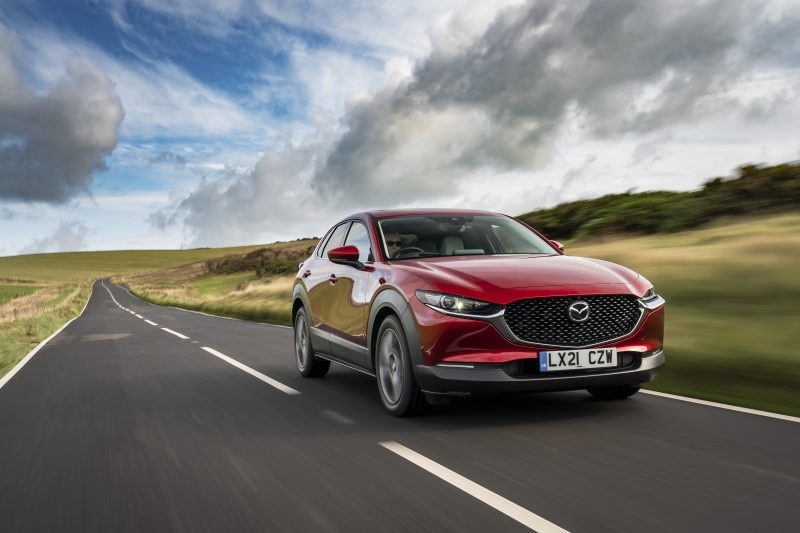The latest 2.0-litre e-SkyActiv X engine produces 186 PS at 6,000 rpm and maximum torque of 240 Nm at 4,000 rpm - an increase of 6 PS and 16 Nm respectively. The torque improvement is most noticeable from 2,000 rpm onwards, however e-SkyActiv X’s torque output has improved in almost all engine speed ranges, and particularly under acceleration from partial-load driving situations most commonly found during daily driving. Even better, efficiency has also been improved, with CO2 emissions dropping by 5 to 11 g/km - depending on model, transmission and trim level. Corresponding improvement in WLTP combined economy further increases the appeal of Mazda’s unique SPCCI petrol engine.
As an example the AWD GT Sport CX-30 automatic now emits 11 g/km less CO2 with a 2.4 mpg improvement in combined WLTP economy, while the entry-level front-wheel drive manual SE-L Lux CX-30 is 6 g/km cleaner and is 2.5 mpg more fuel efficient. The updates to Mazda’s 2.0-litre Spark Controlled Compression Ignition engine have been achieved through adjusting the compression ratio from 16.3:1 to 15.0:1, while other modifications include the optimisation of combustion control, modified pistons and updating the Mazda M Hybrid mild-hybrid system’s software.
This results in a broader operating band of combustion efficiency, which ensures e-SkyActiv X not only delivers higher maximum engine torque but also improves real-world fuel economy. The intake valve timing has been adapted through modifying the intake camshaft, this leads to a reduction in pumping losses and further increases the engine’s specific heat ratio, resulting in improvements to the e-SkyActiv X’s fuel consumption.
Additionally to the updates to the combustion engine, the Mazda M Hybrid mild-hybrid system has had a software update that enables faster reactions of the system’s belt-driven ISGs torque control. This improvement on control smooths drivability by increasing or reducing torque control when needed. For example, when the e-SkyActiv X’s air supply unit turns on - to provide sufficient air needed for a lean combustion fuel-air mixture - or off again, the units inertia creates torque fluctuations. The Mazda M Hybrid’s enhanced software enables torque reactions issued through the belt-driven ISG that are quick enough to flatten the torque curve. As a result, the engine feels even smoother during linear acceleration.
Corresponding to the renaming of the e-SkyActiv X engine, Mazda’s 2.0-litre SkyActiv-G engine is moving to e-SkyActiv G naming and across the CX-30’s 122 PS 2.0-litre range CO2 has been reduced by 7-8 g/km. On sale now, the 2021 Mazda CX-30 lineup features nine e-SkyActiv G models, which are offered exclusively with front-wheel drive in SE-L, SE-L Lux, Sport Lux, GT Sport and GT Sport Tech trim levels with the option to go for an automatic transmission on all models with the exception of the entry-level SE-L. The 12-model e-SkyActiv X range sits across the SE-L Lux, Sport Lux, GT Sport, and GT Tech trim levels with the option of automatic transmission throughout the lineup. From GT Sport upwards there’s also the option to choose Mazda’s advanced all-wheel drive system.
On sale from the 1st April, the 2021 Mazda3 sees the same upgraded e-SkyActiv X engine introduced and benefits from 5-11 g/km CO2 reductions alongside the same power and torque improvements. The nine-model 2.0-litre e-SkyActiv G lineup features SE-L, SE-L Lux, Sport Lux, GT Sport and GT Sport Tech trims with the option of an automatic gearbox on all but the entry-level SE-L. The e-SkyActiv X hatchback range features nine cars across SE-L Lux, Sport Lux, GT Sport and GT Sport Tech trims with the option of an automatic gearbox from Sport Lux onwards. Additionally, the stylish 2021 Mazda3 saloon is offered exclusively with the e-SkyActiv X engine with the same nine model lineup as the hatchback.
Small changes to the award-winning Mazda3 see a sunroof added to Sport Lux, GT Sport and GT Sport Tech e-SkyActiv X models.























